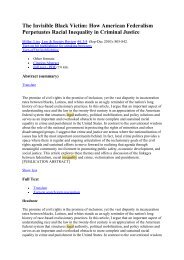Ski – resort and regional development: profile of visitors ... - E-Journal
Ski – resort and regional development: profile of visitors ... - E-Journal
Ski – resort and regional development: profile of visitors ... - E-Journal
You also want an ePaper? Increase the reach of your titles
YUMPU automatically turns print PDFs into web optimized ePapers that Google loves.
Measuring destination competitiveness: an exploratory study <strong>of</strong> the canaries, mainl<strong>and</strong> spain, france, the balearics <strong>and</strong> italy<br />
The factors in quadrant I represent the strengths <strong>of</strong> each destination, since they play a key<br />
role in competitiveness <strong>and</strong> also achieved a high rating for that destination. The factors in<br />
quadrant II are ones in which the destination is well positioned, compared with its rivals,<br />
although they do not play an important role in competitiveness. In fact, they are considered<br />
“wasted efforts”. The factors in quadrant III do not play a decisive role in competitiveness<br />
<strong>and</strong> did not achieve a high rating for the destination in question. Finally, quadrant IV shows<br />
the main weaknesses <strong>of</strong> each destination. These are factors that play a major role in<br />
competitiveness, but the destination is not well positioned in such matters.<br />
A global look at all the target destinations shows that they share the scenery, climate,<br />
accommodation <strong>and</strong> cleanliness <strong>and</strong> hygiene as strong points. Wasted efforts include easy<br />
access to information about the destination <strong>and</strong> the presence <strong>of</strong> friends <strong>and</strong>/or relatives. The<br />
existence <strong>of</strong> facilities for children <strong>and</strong>/or the elderly <strong>and</strong> specific tourism attractions are factors<br />
that achieve a low rating at all destinations but, at the same time, they do not play a decisive<br />
role in competitiveness. Lastly, four factors must be improved on if these destinations are to<br />
become more competitive: the local life style, holidays that suit one’s budget, easy access<br />
from the tourists’ country <strong>of</strong> origin to the destination, <strong>and</strong> historical sites or attractions. Table<br />
2 shows an overview <strong>of</strong> the individual analyses.<br />
Table 2. The importance <strong>and</strong> relative weight <strong>of</strong> tourist attractors for the destinations as a<br />
whole<br />
Aspects to improve on Strengths<br />
Local life style Scenery<br />
Holidays that suit one’s budget<br />
Easy access from the country<br />
Climate<br />
<strong>of</strong> origin to the destination Accommodation<br />
Historical sites or attractions<br />
Non-crucial factors that<br />
Cleanliness & hygiene<br />
achieved low ratings Wasted efforts<br />
Easy access to information<br />
Existence <strong>of</strong> facilities for about the destination <strong>and</strong><br />
children <strong>and</strong>/or the elderly from travel agents, tour operators etc.<br />
Specific tourist attractions Presence <strong>of</strong> friends <strong>and</strong>/or relatives<br />
Source: Own, based on data from the survey<br />
Lastly, a Dem<strong>and</strong> Competitiveness Index (DCI) was created, calculating the weight <strong>of</strong> each<br />
factor within the index (Table 3). Subsequently, the DCI was estimated for each <strong>of</strong> the five<br />
destinations, by calculating the difference between the rating achieved by each destination<br />
Tourism Today - Fall 2007 - Full Paper<br />
73














